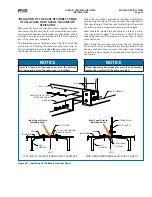
PREINSTALLATION REQUIREMENTS
TRAINING & SAFETY CONSIDERATIONS
The AcuAir
®
precision-engineered hygienic air systems
provided by Johnson Controls-Frick, utilize the finest in HVACR
materials and corrosion protection to deliver dependable,
consistent, and accurate control of temperature and humidity
in process rooms. This manual provides the information
needed for safe installation, operation, and maintenance.
Close attention to the instructions and guidelines provided
will ensure the longest possible system life and dependable,
consistent performance.
CAUTION
Before installing, operating, or maintaining the system,
it is recommended that only experienced
HVACR
contractors, operators, and maintenance technicians
be used (in conjunction with formal training on the
AcuAir
®
system’s design and features). Reading and
understanding of this manual should serve as the
minimum application-specific training requirement.
AcuAir
®
system installation, operation, and maintenance
involves heavy rotating machinery operating at high speed and
high voltage. Normal operations and maintenance procedures
may require working at elevations, enclosed space entry, or
use of hand and power tools. Taking these considerations into
account along with the hygienic nature of AcuAir
®
applications,
it is clear that safety should always be the top priority.
We recommend that every AcuAir
®
system user analyze and
develop an installation-specific safety regime that takes
into account such variables as specific site/system features,
personnel qualifications, hazard identification, etc.
The following elements of operational safety are recommended
for inclusion in every client’s AcuAir
®
system safety plan/
requirements:
NOTICE
Configure all power switches and controls to provide an
open, safe circuit before and during maintenance pro
-
cedures, until the system is cleared by management for
normal on-line operations. For
extended shutdowns, it
is recommended that a qualified technician remove fuses
from “fused-disconnect panels” or otherwise open the
circuit in an accepted, secure manner.
Fans
– All fan covers, guards, and shaft retainers (if any)
must be in place before applying power to an AcuAir
®
system.
Always disengage and lock out power before allowing interior
inspections. To prevent foreign objects from being sucked into
rotating fan blades,
never
allow operation with the doors open.
Enclosed space inspections
– Inspections of coils, filters, etc.,
requires machinery lockout and the use of a “lookout buddy”
at a minimum – consult your internal safety policy and OSHA
requirements for additional recommended safety procedures.
Vibration and noise
– Discontinue or stop machinery that
emits unusual vibration and noise. The source must be
investigated, identified, and corrected before testing or placing
the system back in operation.
Wet Surface Precautions
– Poorly maintained and wetted
machinery requires care to avoid electrical shocks from
inadequate or loose field wiring and connections. All personnel
must lock out and tag machinery before working on the unit.
Proper safety precautions such as the use of insulating soles
and gloves and a trained “lookout buddy” are indispensable.
Ice formation in cold weather can present slip and fall hazards.
Icing safety procedures should be mandatory when the daily
ambient temperature falls below 40°F.
AcuAir
®
systems typically serve in a continuous-duty capacity
and must be properly sited, installed, and connected in the
field (by others) to appropriately sized and installed wiring for
electrical power and controls, air ducting, refrigerant lines, and
fuel piping. The engineering plans, piping layouts, etc. for all
peripheral “field” work should be detailed in accordance with
local and governing codes and the best industry standards
and practices.
If you have any comments or questions regarding this manual
or the AcuAir
®
system, you are urged to call your installing
contractor and/or sales representative.
PRELIMINARY SITE LAYOUT CONSIDERATIONS
All AcuAir
®
systems must be located to minimize the effect
of exhaust air recirculation. Prevailing winds, other structures
or even other air handling units can cause exhausted air to
be drawn back into the AcuAir
®
unit. Short cycling air in this
manner can create an excess cooling load, condensation
load or in cold climates, frost blockages. It is the owner’s
responsibility to properly locate each system and consult with
a qualified engineer before laying out structural or
foundation
supports and installing the AcuAir
®
system.
Sufficient access must always be available to allow adequate
airflow to the AcuAir
®
system fresh air inlet and exhaust
louvers. In general, AcuAir
®
systems should always be placed
on concrete pads, piers or structural steel so that exhaust
air discharge of the fan orifice is at or above the elevation of
nearby walls, structures, and equipment.
For other minimum spacing requirements see the generic
layout in Figure 2 for examples showing an AcuAir
®
system
installed next to a wall.
PRELIMINARY FIELD PIPING DESIGN
CONSIDERATIONS
CAUTION
All AcuAir
®
systems require strongly supported and
properly anchored field piping. NO field piping is to be
supported by the AcuAir
®
system itself. Wind loading,
temperature variation, etc., must be considered to allow
for movement between the system, adjoining building,
ducting, and field piping. A qualified cooling system
design engineer should provide final field-piping plans
and specifications.
Before finalizing piping installation plans, it is recommended
that related plans for system and plant expansion be discussed
with your refrigeration system designer.
210.100-IOM (JUL 2018)
Page 6
ACUAIR
®
HYGIENIC AIR UNITS
INSTALLATION
Summary of Contents for AcuAir
Page 54: ......







































